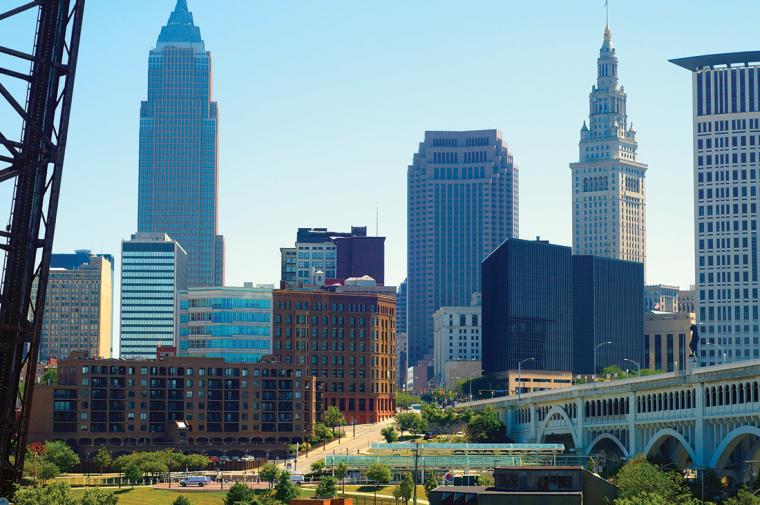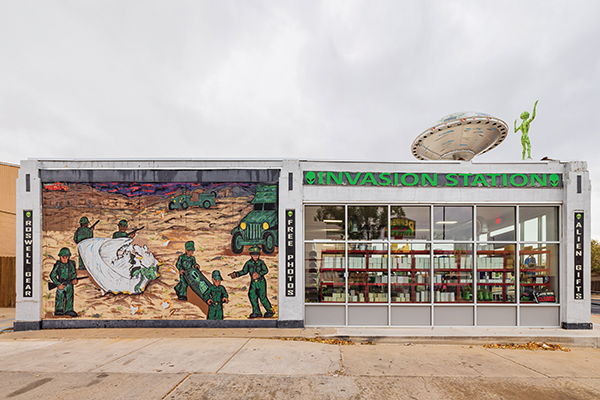
Communities interested in reenergizing their communities are doing so in a variety of ways. The rejuvenation of a community’s downtown area can have a lasting effect, both culturally and fiscally, on a community. The revitalization of downtown spaces often acts as a catalyst for broader community development and revitalization efforts.
By building upon the foundation of the community, focusing on its unique assets and fostering a collaborative and inclusive approach, the reimagination of the downtown area becomes a collective effort that reflects the identity, values and aspirations of the community. This comprehensive approach is key to creating a vibrant and resilient urban core.
Some communities have an event or a piece of history that is a natural draw, bringing potential retail customers, as well as tourists, into town where they frequent shops and restaurants. In Roswell, New Mexico, for example, it is (literally) an out-of-this-world piece of lore that lures tens of thousands of inquisitive visitors to the community. Each one of these visitors is a potential customer.

In all began in the late 1940s when an Unidentified Flying Object (UFO) supposedly crash-landed in the area. And (equally supposedly) the pilot of the UFO was recovered by government officials. The incident was officially reported by the government as the downing of a weather balloon; however, myths and legends have persisted. Even 80 years later, Roswell is known as the site of the crash of a little green man’s flying machine. The city has capitalized on the legend and the myth and has used it to entice visitors to the community.
The constant influx of alien-hunting tourists sustains a strong retail sector in Roswell. The city that is home to over 60,000 residents has a wide variety of retail selections. The selections are not just limited to the typical souvenir shops; the town includes an array of stores and restaurants to service the residents and workers in the community.
The tourism-driven interest led to the creation of a UFO Festival in the mid-1990s; this has become a key part of the revitalization to the downtown area in Roswell. The annual July event features costume contests, lectures, a film festival and other activities. Local shop and restaurant owners have benefited from the consistent tourism traffic in the community.
The Roswell-Chaves County Economic Development Corporation has developed a matching grant program for façade improvements to encourage the beautification of the buildings in Roswell’s downtown area. The façade improvement incentive program in Roswell has paid dividends. Not only have several buildings been renovated, but these efforts have resulted in the opening of new businesses.
A building on the corner of Main Street and Fourth Street in downtown Roswell was one of those locations that took advantage of the program to make improvements to its facade. The new look of the building attracted Sweet Baby J’s Bakery, the home of custom-made cookies, cakes and other pastries.
Roswell’s approach to leveraging its unique history as a tourist attraction, coupled with strategic economic development initiatives, has contributed to a vibrant and thriving community. By enhancing economic opportunities in both the downtown area and the community as a whole, Roswell has not only attracted more visitors but has provided its residents with increased prospects for economic growth and a better quality of life.
The concept of incentivizing the development of new retail business in the downtown area of a community is not unique to Roswell. In Texas, the Weslaco Economic Development Corporation has been supporting local business and property owners with its own incentive program. The program has been so successful in bringing new investment to the historic downtown Weslaco area that it will be expanded to support buildings and businesses in other portions of the Rio Grande Valley community.
Here is one success story: In late 2023, Weslaco attracted retailer Casa Kevin. A purveyor of apparel, housewares, toys and home décor, Casa Kevin located its seventh store in a formerly vacant building in the downtown area. With the addition of Casa Kevin, the historic downtown Weslaco area now boasts a 90 percent occupancy rate.
The success of the local economic development agency is not just limited to the retail merchandisers in the area; multiple dining options have been added as well. Spurred by the incentive program, Buzzed Bull Creamery opened its newest location in downtown Weslaco. With nine current locations and seven more on the drawing board across the county, Buzzed Bull Creamery offers a twist on ice cream favorites with an infusion of alcohol.
Revitalizing a community also can be done in areas that do not have a traditional downtown. One example is the historic community of East Cleveland, Ohio, a suburb of its much larger neighbor, Cleveland. This city can trace its history back to the early days of John D. Rockefeller (of Standard Oil fame) who was a resident of East Cleveland before moving to New York.
In the late 19th century and the early portion of the 20th century, the community was thriving with nearly 40,000 residents, although its population is considerably lower now. East Cleveland Growth Association, a private non-profit, has undertaken an effort to improve the retail shopping opportunities in the community, beginning with a survey of local residents to find out what type of new or expanding retail options they wanted.
“The retail study that was done gave us a better understanding of what the residents wanted to see in the community,” said Sean Ward, CEO and founder of East Cleveland Growth Association. “This was the foundation needed to further our work to bring new shopping options back to our community.”
Retailers used questions to gather data on the best place to locate new outlets: How many people live within a certain drive time of a proposed location? What is the income of the families in the area? What is the business environment like? The answers form the data to be used by prospective retail company decision makers. Having an analysis of the retail market in a given area goes a long way toward helping a community gain commitments from desired brand names.

“Since we undertook our study, our community has seen a few new restaurants and stores open in our central business corridor,” said Ward. “This has been a small but happy victory in restoring economic vitality to East Cleveland.”
Efforts are ongoing to attract new retail stores and restaurants into the community’s central business district along Euclid and Superior Avenues.
“We understand this is a long-term process,” said Ward. “We are committed to doing this work for the long haul.”
Supporting revitalization of a community’s downtown district by encouraging the development of new small businesses and retail creates an additional opportunity for leaders in that community to consider. The second, third and even fourth stories of those buildings in the core downtown offer additional possibilities: Housing.
Years ago, many of these buildings offered housing to the shopkeepers and their families. Today, they can be rehabilitated to create housing in the downtown area. Individuals and families who might avail themselves of the residential options are also potential customers to the businesses on the street level in the area.
The two groups complement each other. Retailers and restaurant owners and operators will benefit by having those with disposal income residing in the downtown area. Potential residents will be drawn to living in the downtown area because of the variety of dining and shopping options within walking distance.
There is another benefit associated with the rejuvenation of the upper floors of downtown buildings: Building owners will have another source of revenue to support the investment required for the redevelopment of their properties.
Community planners considering, or those who are already actively engaged in, redevelopment plans for their downtown need to take into consideration another key factor that can add to (or subtract from) an area’s appeal: Parking. Increased retail and dining establishments in the downtown area will bring customers. Customers prefer parking areas that are convenient and accessible to the establishments they want to patronize. This holds true especially when those customers receive top-notch service and products that are affordably priced.
Good service with a good product line selection equals repeat businesses. Having residents who occupy the upper levels of the downtown buildings will bring more cars as well. While having more customers and more residents is desirable, it can (and usually does) generate parking problems. Setting aside space for parking is an important part of successful planning for downtown revitalization.
So, with the anticipated increase of visitors coming from outside of the community to experience the new and wonderful revitalized city’s downtown area, how can you guarantee they will find what arouses their interest? That’s right: Wayfinding.
Wayfinding is the art of placing signage throughout an area visitors are expected to frequent in a community, such as the downtown shopping and dining district. Attractive signage can help guide those who are not familiar with the area to the cultural sites such as the museums, theaters, historic sites, parks or the local zoo.
Signage can also be used to point visitors in the direction of the conveniences they will need: designated parking facilities, tourist information areas and restrooms. Effective wayfinding is an essential element in creating a positive and memorable experience for visitors, encouraging them to explore and engage with the various offerings in a revitalized downtown area.
The business establishments in the downtown district also need effective signage to help draw customers inside. Both the wayfinding signage and the business signage in the area need to be attractive and have a pleasing eye-catching design. A theme for the area helps in creating such signage and can be used to guide pedestrians as well as motorists.
Effective business signage in the downtown district contributes not only to the success of individual establishments but also to the overall vibrance and attractiveness of the area. It serves as a key element in the visual identity of the district, inviting customers to explore and engage with the diverse offerings available.
By integrating effective wayfinding strategies that specifically cater to shopping and dining experiences, the downtown district can create a positive environment that informs visitors and encourages them to explore, shop, dine and return in the future.
Revitalizing a downtown area to improve retail shopping and dining attractions in the area is not an easy task, nor is it something that can be (or should be) done in a short period of time. However, it is a worthwhile endeavor for those wanting to improve the downtown area in their communities.
By using these techniques, visionary leaders can inspire and guide a community toward a revitalized downtown that not only enhances the retail and dining experiences but also contributes to the overall well-being and vibrancy of the area and lends itself to a better quality of life.
Despite the challenges, successful downtown revitalization projects have been implemented in a variety of communities worldwide. By addressing these challenges systematically, leveraging community strengths and maintaining a long-term perspective, it is possible to create a vibrant and thriving downtown area that attracts both residents and visitors. T&ID

